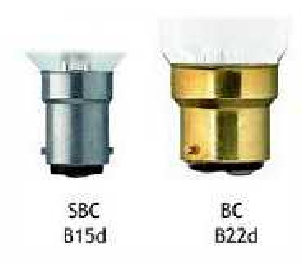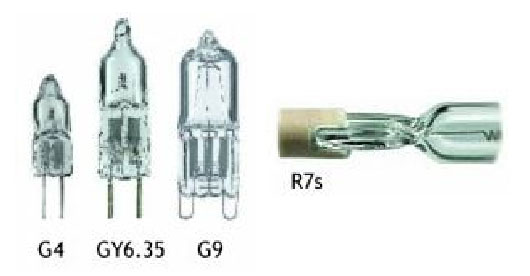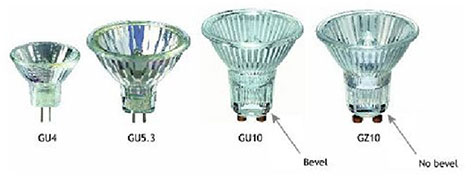Fittings ( Caps & Bases)
The part of the lamp that connects into the light fitting is generally known either as the “cap” or “base”. This provides the electrical contact and also often the physical location of the lamp. A vast variety of caps and bases exist in order to help make sure that only the correct type of lamp is used in any given fitting. This section shows many of the most popular fittings.
Baynet
 With its familiar “push and twist” action, “bayonet cap” (also known as BC or B22d) is used on most regular light bulbs. It is 22mm diameter and with two locating lugs.
With its familiar “push and twist” action, “bayonet cap” (also known as BC or B22d) is used on most regular light bulbs. It is 22mm diameter and with two locating lugs.
The “small bayonet cap” (SBC or B15d) is very similar but only 15mm across.
Although generally used for mains voltage lamps, the SBC fitting can also be found in a very small number of specialist low voltage halogen lamps.
There are also many other “BC” variants including the 3-pin BC, B22d-3 sometimes used on Fireglow lamps but perhaps more commonly on High pressure mercury lamps for industrial applications. The BY22d is used on some low-pressure sodium (SOX) lamps.
Edison Screw Cap
 Named after the pioneering inventor Thomas Edison, the Edison Screw or “ES” lamp fitting is used worldwide in a vast range of applications.
Named after the pioneering inventor Thomas Edison, the Edison Screw or “ES” lamp fitting is used worldwide in a vast range of applications.
The most popular ES or E27 fitting is 27mm diameter and is widely used in both the US and Europe. The SES is often used for smaller decorative fittings, chandeliers, and appliance bulbs – predominantly in the UK and Europe. CES is most frequently used in the US and Canada, especially for candle bulbs. The MES fitting is sometimes used in large chandeliers containing perhaps dozens of small lamps.
The GES is rarely used in domestic applications and is typically for lamps over 500W. This must not be confused with the extremely similar US standard 39mm diameter E39 or Mogul Screw fitting
The most commonly used screw fittings are shown in the table below. Other, less frequently used, sizes include E11, E17 and E26.
Halogen Capsules
 Miniature halogen capsule lamps are generally designated by the measure in mm between the pins (for example the G4 has pins 4mm apart).
Miniature halogen capsule lamps are generally designated by the measure in mm between the pins (for example the G4 has pins 4mm apart).
The G4 and GY6.35 are always used in low voltage applications whereas the G9 is for 240v mains use.
Linear Halogen capsules for floodlights and up-lighters have a 7mm R7s cap at each end of a long quartz capsule.
Halogen Spotlights
 The most common halogen spots are either push fit (GU4 or GU5.3), low voltage type or twist and lock (GU10 or GZ10) mains versions. PLEASE NOTE the subtle difference between GU10 and GZ10. The GU10 has a bevel around the base but the GZ10 has a square corner. This stops the GZ10 being used in a fitting designed for a GU10 but allows the GU10 to be used in either.
The most common halogen spots are either push fit (GU4 or GU5.3), low voltage type or twist and lock (GU10 or GZ10) mains versions. PLEASE NOTE the subtle difference between GU10 and GZ10. The GU10 has a bevel around the base but the GZ10 has a square corner. This stops the GZ10 being used in a fitting designed for a GU10 but allows the GU10 to be used in either.
Fluorescent tubes
 Fluorescent strips generally have a two-pin fitting at both ends of the tube.
Fluorescent strips generally have a two-pin fitting at both ends of the tube.
Standard size T8 (25mm) and the larger T12 (38mm) tubes both use the G13 fitting.
The smaller T5 (16mm) tubes use the G5 fitting with 5mm between the two pins.
Incandescent strip Lights
 Architectural strip lamps are available with two different fittings. One type has two S14s connectors one near either end of the lamp.
Architectural strip lamps are available with two different fittings. One type has two S14s connectors one near either end of the lamp.
The so-called centre-peg version has a single central S14d connector with two contacts.
Conventional strip lights (also known as picture lamps) generally use a 15mm diameter S15s fitting at each end of the lamp.
Compact Fluorescent

Compact fluorescent lamps (CFLs) without integrated control gear generally use push-fit square or rectangular fittings. Those with integral starters use 2-pin fittings those for use with electronic control gear and/or dimmers have 4-pin connectors. Some of the most popular connectors are shown below. Two-pin Triple turn CFLs use the GX24d-1/2/3 fitting (not shown). Four-pin Triple-turn CFLs use the GX24q-1/2/3/4 (not shown). 2D lamps use either the GR8 (2-pin) or GR10q (4-pin) connector.







